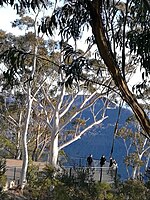Leuralla
1913 establishments in AustraliaEngvarB from September 2019Houses completed in 1913Houses in New South WalesRailway museums in New South Wales ... and 2 more
Toy museumsTransport museums in New South Wales

Leuralla is a historic house and home to the Leuralla Toy & Railway Museum, which closed in 2022. The property is located in Leura, a suburb in the Blue Mountains, in New South Wales, Australia.The present house was built between 1910 and 1914 and was designed by architect Edward Hewlett Hogben. The garden was developed around the 1914 house and is 5 hectares (12 acres) in size. A formal garden lay out was used originally by Andreas and later Paul Sorensen improved the garden overall. An amphitheatre is located on the edge of the escarpment and overlooks the Jamison Valley.
Excerpt from the Wikipedia article Leuralla (License: CC BY-SA 3.0, Authors, Images).Leuralla
Olympian Place, Sydney
Geographical coordinates (GPS) Address Nearby Places Show on map
Geographical coordinates (GPS)
| Latitude | Longitude |
|---|---|
| N -33.7246 ° | E 150.3297 ° |
Address
Leuralla Gardens
Olympian Place
2780 Sydney
New South Wales, Australia
Open on Google Maps









